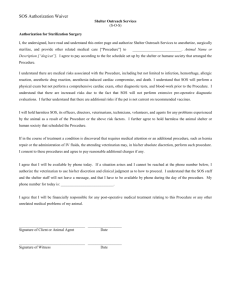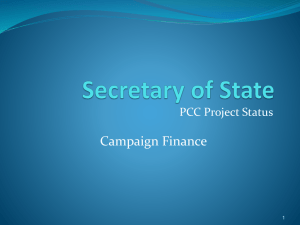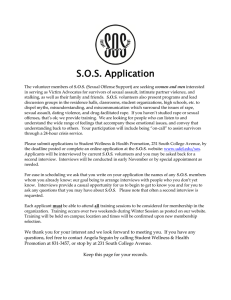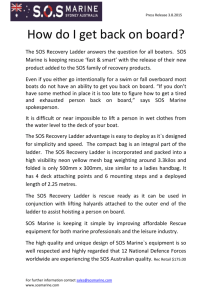Cost and Risk Considerations for Test and Evaluation of Unmanned and :
advertisement
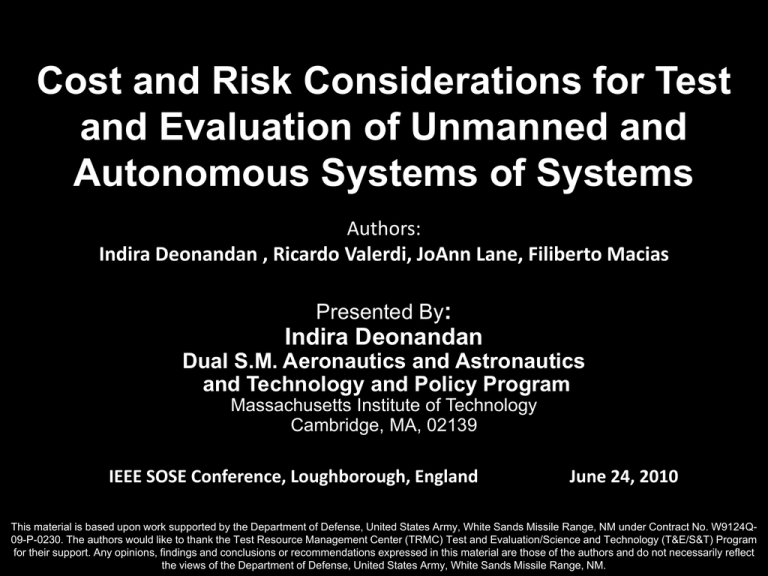
Cost and Risk Considerations for Test and Evaluation of Unmanned and Autonomous Systems of Systems Authors: Indira Deonandan , Ricardo Valerdi, JoAnn Lane, Filiberto Macias Presented By: Indira Deonandan Dual S.M. Aeronautics and Astronautics and Technology and Policy Program Massachusetts Institute of Technology Cambridge, MA, 02139 IEEE SOSE Conference, Loughborough, England June 24, 2010 This material is based upon work supported by the Department of Defense, United States Army, White Sands Missile Range, NM under Contract No. W9124Q09-P-0230. The authors would like to thank the Test Resource Management Center (TRMC) Test and Evaluation/Science and Technology (T&E/S&T) Program for their support. Any opinions, findings and conclusions or recommendations expressed in this material are those of the authors and do not necessarily reflect the views of the Department of Defense, United States Army, White Sands Missile Range, NM. 2 of 15 The Challenge What is a UAS? Why UAS? Why UASoS? The evolutionary nature of Unmanned and Autonomous Systems of Systems (UASoS) acquisition needs to be matched by evolutionary test capabilities yet to be developed. Singer, P. W., Wired For War: The Robotics Revolution and Conflict in the 21st Century (Penguin, 2009) Introduction Introduction Objectives Motivation Methodology Results Impact Summary The Prescriptive and Adaptive Testing Framework (PATFrame) 3 of 15 Why focus on testing? Test Strategy/ Test Infrastructure • Need for T&E processes to recognize levels of effectiveness • Need to focus on the interactions between components and emergent behaviors System under test • Need to move away from boundaries between DT and OT http://mit.edu/patframe Introduction Introduction Objectives Motivation • Need ability to make effective contingency plans as requirements change Methodology Results Impact Summary 4 of 15 Three main objectives Understand the role of effort estimation in UASoS testing Introduction Objectives Objectives Understand the limitations of existing cost estimation models Motivation Methodology Show how our model can be merged with cost estimation processes Results Impact Summary 5 of 15 The need for effort estimation of UASoS testing • There comes a point when effort invested does not reduce risk at a justifiable rate • Emergent properties especially when UASoS fielded for the first time drive up costs • Current projects are based on similar past projects and extrapolations that do not account for other risks • Produce strategic options and guidance to improve confidence and ability to prioritize • Avoid unreliable estimates and unfavorable system performance • Finding problems before delivery is much cheaper and less time consuming Introduction Objectives Motivation Motivation Methodology Results Impact Summary 6 of 15 Data Sources Literature Review • Existing DoD procedures on testing • Cost modeling techniques • Risks and costs of UASoS Interviews • Program managers, researchers, subject matter experts, DoD personnel • Risks identification and Resource estimation Surveys • Gather cost driver data from subject matter experts Case Studies PATFrame Workshops Introduction Objectives Motivation • Quantitative inputs to cost model • Validation of cost model • Use these as an opportunity for interviews and feedback Methodology Methodology Results Impact Summary 7 of 15 Existing Cost Modeling Approaches (1) Cost Estimation Method Focus Limitations COSYSMO Constructive Systems Engineering Cost Model (Valerdi, 2008) Estimate system engineering effort Only applicable at the single system level COSOSIMO –Constructive Systems-of Systems Integration Cost Model (Lane, 2009) Estimate the system engineering effort for development of SoS, …integration of the SoS components into the SoS framework Does not account for flexibility and emergent behaviors of complex SoS testing “Bridge the gap between software test processes and business value” (Li et al, 2009) Value based testing to better align investments with project objectives and business value Introduction Objectives Motivation Methodology Methodology 1. More applicable to business critical projects rather than safety critical domains 2. Is tailored to software testing Results Impact Summary 8 of 15 Existing Cost Modeling Approaches (2) Cost Estimation Method Focus Limitations “Managing your way through the integration and test black hole” (George ) Integration effort = (number of predicted defects * average time to find and fix a defect) + (number of test cases * the average time to run a test case) 1. Assumes only issue with integration testing is defects which are easy to find 2. Assumes fixing one defect does not create another “Sizing systems test for estimating test execution effort” (Aranha and Borba, 2007) Estimate the size of a software test which is required to determine the test execution effort 1. Assumes test size = number of steps to complete test and complexity = relationship between tester and product 2. Does not account for other cost drivers in UASoS testing Introduction Objectives Motivation Methodology Methodology Results Impact Summary The Boehm Seven Step Modeling Methodology Analyze Existing Literature 1 9 of 15 Development of hypothesis Perform Behavioral Analysis 2 Identify Relevant Significance 3 Barry Boehm, Chris Abts, A. Windsor Brown, Sunita Chulani, Bradford K. Clark, Ellis Horowitz, Ray Madachy, Donald J. Reifer, and Bert Steece, Software cost estimation with COCOMO II, Englewood Cliffs, NJ:Prentice-Hall, 2000 Scaled inputs to cost model Perform Expert Judgment Delphi Analysis 4 Identify and Gather Project Data 5 Merging qualitative and quantitative data Combine Historical Data with Delphi Analysis 6 Gather more data, Test Model, Refine Model 7 Introduction Objectives Motivation Methodology Methodology Results Impact Summary 10 of 15 Ranking of Technical Cost Drivers | n=10 Number of systems to be integrated 4.71 Integration complexity 4.57 Complexity of tests 4.43 System synchronization complexity 4.43 Technology maturity of SoS 4.43 Number of requirements of the SoS 4.43 Diversity of tests 4.14 Level of safety 4.14 Number of interfaces in the SoS 4.14 Technical Cost Driver Changes in the requirements of the SoS 4.00 Breakdown in communication links 4.00 Varying levels of maturity of technology 4.00 Number of tests 3.86 Coordination requirements to access systems 3.86 Availability of testing infrastructure 3.71 Degree of autonomy of individual systems 3.71 Interoperability of manned and unmanned systems 3.71 Migration complexity 3.71 Type of testing 3.57 Match of material availability and schedule requirements 3.57 Reuse of equipment and infrastructure 3.57 Number of missions 3.57 Coordination of system platforms 3.57 Diversity of platforms within the SoS 3.57 Rate of test data collection and analysis 3.43 Maturity level of test 3.43 Power availability for adapting new technologies Complexity of test Data collection rates Maturity level of test Power availability 2.86 0 Objectives Integration complexity 4.14 Type and complexity of operational environment Introduction Number of systems Motivation 1 2 3 Methodology Score 4 5 Results Results Impact Summary 11 of 15 Ranking of Organizational Cost Drivers | n=10 Time constraints 4.62 Organizational Cost Driver Understanding of the architecture of the SoS 4.50 Personnel experience 4.25 Personnel and team capability 4.25 Understanding of the project requirements 4.25 Personnel and team continuity 4.12 Availability of resources to assist integrated test 4.12 Understanding of integration of requirements 4.12 Appropriate allocation of resources Time constraints Architecture understanding Personnel experience 3.88 Reuse of existing plans 3.63 Reuse of existing test strategies and methods 3.63 Test process capability 3.63 Number of organizations involved in SoS testing 3.63 Security level of the project 3.63 Stakeholder team cohesion Stakeholder team cohesion Multisite coordination 3.50 Multisite coordination Test planning tool support 3.38 Support from test planning tools 3.25 0 1 2 3 4 5 Score Introduction Objectives Motivation Methodology Results Results Impact Summary 12 of 15 The Boehm Seven Step Modeling Methodology Analyze Existing Literature 1 Development of hypothesis Perform Behavioral Analysis 2 Identify Relevant Significance 3 Barry Boehm, Chris Abts, A. Windsor Brown, Sunita Chulani, Bradford K. Clark, Ellis Horowitz, Ray Madachy, Donald J. Reifer, and Bert Steece, Software cost estimation with COCOMO II, Englewood Cliffs, NJ:Prentice-Hall, 2000 Scaled inputs to cost model Perform Expert Judgment Delphi Analysis 4 Identify and Gather Project Data 5 Merging qualitative and quantitative data Combine Historical Data with Delphi Analysis 6 Gather more data, Test Model, Refine Model 7 Introduction Objectives Motivation Methodology Results Impact Summary 13 of 15 Impact • Test and Evaluation Planners • • • • Program Managers • • • provide tradeoff analyses between costs and risk mitigation provide support in day to day testing procedures helps with more efficient use of time and resources better allocation of resources (time and money) based on cost estimates better coordination of multiple programs DoD Policy Makers • • give evidence of budgeting requirements for testing projects ensure adequate testing of UASoS to be used Introduction Objectives Motivation Methodology Results Impact Impact Summary Summary 1. There is need for optimized testing strategies for UASoS • UASoS are in more demand in the DoD • The advances in the technology need to be matched by advances in testing capabilities 2. Provide program managers, test conductors, and policy makers • • • An integrated decision support system for testing UASoS A means to predict how much effort is required to conduct a test of UASoS while minimizing risk A basis to perform cost and risk tradeoffs and prescribe how tests can adapt depending on resource or schedule constraints Introduction Objectives Motivation Methodology Results Impact Summary Summary 15 of 15 Author Contact Information Indira Deonandan Ricardo Valerdi Department of Aeronautics and Astronautics Engineering Systems Division Massachusetts Institute of Technology Massachusetts Institute of Technology Cambridge, MA, 02139 Cambridge, MA, 02139 indira@mit.edu rvalerdi@mit.edu Jo Ann Lane Filiberto Macias Systems Engineering Research Center University of Southern California Los Angeles, CA 90089 jolane@usc.edu Systems Engineering Directorate US Army White Sands Missile Range New Mexico Filiberto.a.Macias@us.army.mil Introduction Objectives Motivation Methodology Results Impact Summary Summary 14 of 15 Summary • Test and Evaluation Need – Accelerate test planning for UASoS by supporting automation of current human-intensive (thus potentially error-prone) SoS test planning process – Optimize the joint mission oriented UAS T&E strategy by addressing and balancing multiple criteria – Predict, detect, and adapt to undesirable emergent behavior in UASoS T&E • Science and Technology Challenge – Perform R&D of a multi-dimensional framework for knowledge representation across UASoS • R&D an ontology for key UAS SoS elements, relationships, and constraints • R&D critical UAS SoS design idioms and rich architectural models • R&D parametric UAS SoS project cost/effort models – Perform R&D to develop analyses and simulations across SoS models – Develop a Decision Support System (DSS) prototype that includes the multidimensional framework for analysis and simulation Introduction Objectives Motivation Methodology Results Impact Summary Summary


